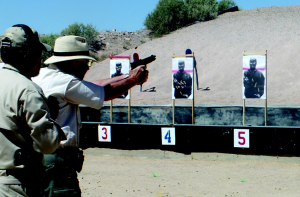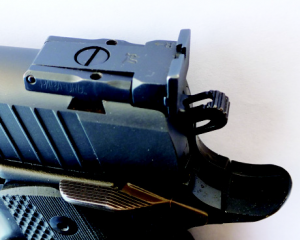by Dick Jones | Contributing Editor
One of Remington Outdoor Company’s more recent acquisitions has been Para USA. In a recent trip to Gun Site, in Pauldin, AZ, I spent some time with Daniel Cox, product manager for the Para line.
“In 2010 and 2011, prior to the acquisition of Para USA, the company was suffering from quality control issues,” Cox reported. “Our best estimate is that the warranty return rate was approximately 7% at that time. Since then we have integrated the use of premium components, premium finishes, and state of the art, enhanced quality control measures.
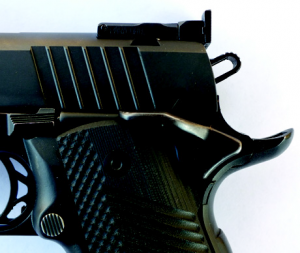
A generous Beavertail and extended ambidextrous safety complement the competitive nature of the Para Custom.
Since that implementation, we’ve diligently tracked warranty concerns and are happy to report we’re now seeing less than 1% of our products return for service of any kind. We’ve spared no expense or effort to ensure we’re now making one of the finest 1911s in the world. Despite these quality control measures only having been implemented in the last few years, we’re proud to service any gun made after January 1, 2001 with our limited lifetime warranty.”
The headquarters for Remington Outdoor Company, the official name for the company that owns Remington, Marlin, Bushmaster, DPMS, Harrington and Richardson, Dakota Rifles, and several other outdoor and shooting related companies, is on Remington Drive, in Madison, NC, just a few miles from my home. Para USA builds its pistols at their plant in Pineville, NC. Para’s line of pistols is based on the long standing Browning 1911 design, commonly described as a Colt .45 Automatic. The design itself is remarkable enough, since it was patented in 1908 and approved by the Army in 1911. While the design is 105 years old, it is still the most popular design for semi-automatic pistols in the world, and 1911-based guns probably win more pistol competitions than all other designs put together.
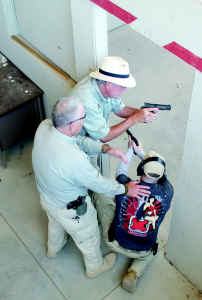
While the Custom line of Para aren’t meant as defensive or combat handguns, they would certainly serve well. Here Chris Weare shows Galco’s Mike Barham and me the proper way to clear a room.
The reason for my trip to Gunsite was to test the latest offerings from Para. I wasn’t unfamiliar with Para because I used one in the 2011 Bianchi Cup. The gun I used was the 18/9, a double-stack 1911 that had been modified to enhance its already capable performance. I put well over 2,000 rounds through the 18/9 in a two-month period and it didn’t malfunction a single time. The gun we tested on this trip was the Para 14/45, a sport/competition pistol chambered for the .45 Automatic Colt Pistol cartridge, otherwise known as the .45 ACP.
While the Custom 14/45 isn’t an all-out competition gun, it has features that lean towards recreational sport shooting and competition.
Foremost in the changes from the time-honored history of the 1911 is the magazine capacity of Para’s double-stack frame. A high percentage of this type of pistol sees some form of competition use and larger magazine capacity is a boon to most competition shooters. In most practical pistol competition, the shooter can utilize all the round capacity the pistol is capable of. With a magazine capacity of 14, the Para 14/45’s double-stack magazine has fully twice the magazine capacity of the early 1911s. The rear of the magazine also has witness holes to allow the shooter to instantly tell how many rounds are still in the gun. This can be a big advantage in competition because it allows the shooter to manage his rounds and magazines instantly.
Guns like the Para 14/45 aren’t meant for selfdefense, though the 14/45 could serve in this capacity.
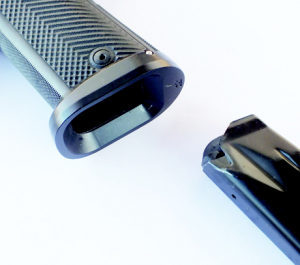
Few guns in this price range come with an extended competition magazine well. Magazine changes were fast and positive.
It’s a bit large and heavy for anyone to use as an everyday carry gun with a loaded weight of three pounds and four ounces. This is a big gun with a large grip to accommodate the doublestack of beefy .45 ACP rounds. In spite of the bulk, guns like the 14/45 are popular with Special Forces and other operators because of the level of power and firepower concentrated in an accurate, if a little heavy, package.
The .45 ACP cartridge the 14/45 shoots is widely considered to be one of the best, if not the best and most effective, military pistol calibers of all time. Because of this, many soldiers in our current conflict in Afghanistan prefer double-stack 1911 .45s over their issue 9mm Berettas. Fortunately, my intended use of the Para is only on steel and paper targets and for this, it also does really well. Para does make versions of the 14/45 that are more suitable for law enforcement and military in the Tactical, Elite, and Expert lines. These guns have simpler sights, are more compact, and cost less than the Custom model.
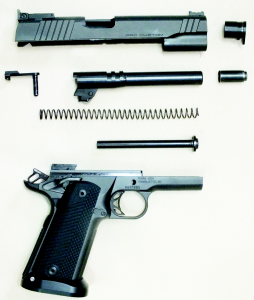
After well over a thousand rounds, you’ll notice very little wear on internal parts due to the Ion bond finish.
Other features for sport shooters are the extended magazine well, that creates a tapered opening in the magazine well to allow quick magazine changes. The 14/45’s quality adjustable rear sight is big and visible and adjusts easily. It’s the Bo Mar-type sight with a large flat rear surface, full sized adjustment screws and positive clicks. There’s also a fiber optic front sight with a green insert. Both sights are dovetailed into the slide, making front sight changes to meet personal preference, simple.
The skeletonized, medium-reach trigger is adjustable for reduction of backlash and broke at under four pounds on my test gun. There’s an ambidextrous, competition style, safety and a 5” stainless Match- Grade ramped barrel with a full length spring guide rod. There is ample checkering on the front and flat rear strap and aggressive grip panels to allow a better grip. All this combines to create a serious .45 that’s fun to shoot, accurate, and reliable. Internally and externally, the Para Custom line has a new Ionbond PVD finish that’s more durable than bluing and requires less lubrication. Each gun comes with two 14 round magazines, and for an MSRP of $1,449.00, this is a lot of gun.
Double stack guns can be a handful and double stack .45s are a powerful handful. At this time, I’ve put about 1,600 rounds through the Para Custom 14/45 without a single malfunction. The 14/45 had great recoil characteristics for an unmodified, factory gun, in spite of the 18- pound spring the company uses to insure reliability. We were shooting with Para USA product line manager, Daniel Cox, and Travis Tomasie, Para’s spokesperson and professional shooter. After 600 rounds of training exercises, I did have some chafing from the edge of the frame at the juncture of the grip safety, but 600 rounds of .45 is a lot of shooting. My only other problem came from my hand construction, because none of the other guys noticed it. I’ve noticed that I sometimes have trouble compressing the grip safety with double stack 1911s when I try to rest my right thumb on the safety. The web of my hand is quite thin and there simply isn’t enough meat there to reliably compress the grip safety.
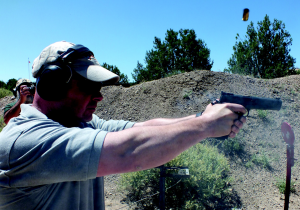
Travis Tomasie put the 14/45 through the paces for us. Para product line manager Daniel Cox was no slouch.
I’ve found I need to modify my grip slightly or I need a more beefed up bottom surface on double stack 1911s.
The Para Custom 14/45 is certainly accurate. Test targets of ten unsupported shots at ten yards made ragged holes. Off the bench with hardball match, I managed groups averaging just under two inches at 25 yards. Recoil is quite comfortable and muzzle rise is moderate. While I am not a speed shooter, I was able to run the plates clean at 10 and 15 yards and easily stay under the time limit with 230-grain hardball. With great sights and trigger and all the ergonomic features competitive shooters usually add, this is a ready to run pistol.
Since Freedom Group purchased Para USA, they’ve done a lot to improve the line and the 14/45 line is one of the first lines to get this attention. Quality problems have been reduced since the revamp, and the guns have added features to make them more suitable for the projected use. As they progress through the product line, I believe we can look forward to some great guns.
The Custom 14/45 certainly is one.

